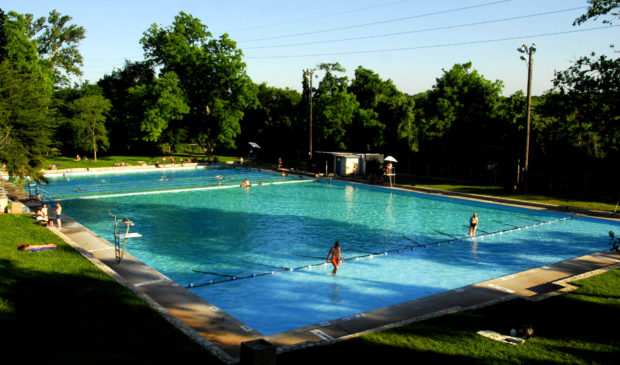City likely to exceed its budget for pools, again
Wednesday, January 17, 2018 by
Jack Craver While City Council members have decidedly mixed opinions about a proposed $124 million bond aimed at upgrading Austin’s aquatics system, everybody acknowledges that the city’s pools are in desperate need of repair.
The problem, of course, is that right now the Parks and Recreation Department doesn’t have the money needed to make even small but important improvements to the aging pools.
Last year, for instance, Council instructed PARD to explore putting in place new technology that would allow the department to monitor the chemical content in pools remotely, without having to have a “technician physically present at a given pool.”
The status quo leads to all kinds of problems that could be avoided with a more efficient, precise system, wrote Interim Director Kimberly McNeeley in a memo to Council last week. The increased “bather loads” during the hot summer months lead to an “increase of contaminants” in the pools, the consequences of which include “odor, discoloration and algae growth” as well as “infections and irritation for bathers.”
The poor system of chemical treatment is made worse by the fact that many of the system’s older pools are constantly leaking massive amounts of water. The more people using a pool, the more quickly the “properly-treated water” leaks out, leading to a drop in chemical levels and unsafe swimming conditions, says the memo.
After assessing the different remote testing technology available, PARD recommends buying a technology that will “remotely control and adjust chlorine and other chemicals” and hopefully lead to cleaner water, less damage to pipes and pool equipment, better use of staff time and department vehicles and, perhaps most importantly, “improved customer service” and “bather comfort.”
However, there is no expectation that remote testing will significantly reduce costs in the long run.
“Fiscally, it doesn’t help shore up our budget,” McNeeley told the Austin Monitor.
To buy and install the new technology at the city’s 51 pools and splash pads will cost $300,000 upfront and $9,000 a year afterward. Right now, said McNeeley, PARD doesn’t have the money needed to do that.
In fact, McNeeley anticipates that, as it has in past years, the department’s Aquatic Division will exceed its annual budget by roughly $400,000. In the past, she said, PARD has covered pool overages by reallocating funds from other department programs. The department is prepared to do that again, said McNeeley, but that would likely threaten other park priorities, including playground and trails maintenance.
Therefore, if it wants cleaner, comfier pools and does not want to damage other parks initiatives that it committed to when it approved the city’s operating budget last year, Council will have to approve a $309,000 increase to PARD’s budget.
Jodi Jay, the manager of the PARD Aquatic Division, said that the new technology will not change the department’s practice of sending an employee to check on each pool’s chemical levels daily, as required by health code. However, it will prevent some “repeat trips,” she said.
A day after requesting those funds, McNeeley sent another memo to Council describing two of the decision-making tools included in the Aquatic Master Plan that PARD plans to rely on when deciding whether an old pool should be repaired or shut down.
The first tool – the Aquatic Facility Sustainability Baseline – is relatively straightforward. If a necessary repair is less than 50 percent of the pool’s annual operating cost, it should be made. If it costs more, PARD will use another tool – the Site Suitability Index – to determine whether the pool is worth saving. The Site Suitability Index draws on a variety of data, including pool attendance and the population of the surrounding area, as well as how this is anticipated to change in the coming years.
Some Council members have bristled at the notion of any possible pool closures, while others have balked at the spending necessary to keep the city’s dozens of aquatics facilities operating when the city is pressed to fund other major priorities, notably affordable housing, infrastructure and public safety.
In the coming months, Council will have to determine the size of a major, multipurpose bond that finances a variety of city needs to submit to the voters for approval this November. At the same time, Council will also have to decide what it wants to do about a proposal to add to the ballot a separate bond specifically for pools. While the Aquatic Master Plan Task Force has recommended $124 million for that measure, some members of Council have said that they will not support a figure that large.
Photo by Steve Hopson (SteveHopson on en.wikipedia) (Photograph created by Steve Hopson, Stevehopson.com) [CC BY-SA 2.5 or CC BY 2.5], via Wikimedia Commons.
The Austin Monitor’s work is made possible by donations from the community. Though our reporting covers donors from time to time, we are careful to keep business and editorial efforts separate while maintaining transparency. A complete list of donors is available here, and our code of ethics is explained here.
You're a community leader
And we’re honored you look to us for serious, in-depth news. You know a strong community needs local and dedicated watchdog reporting. We’re here for you and that won’t change. Now will you take the powerful next step and support our nonprofit news organization?






